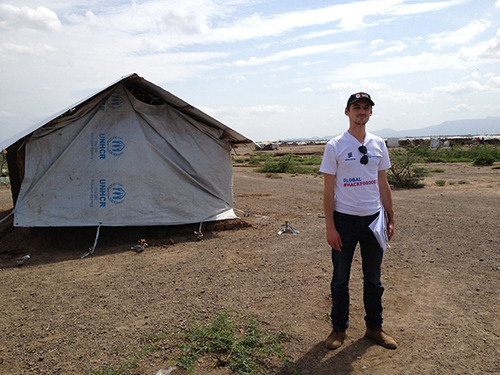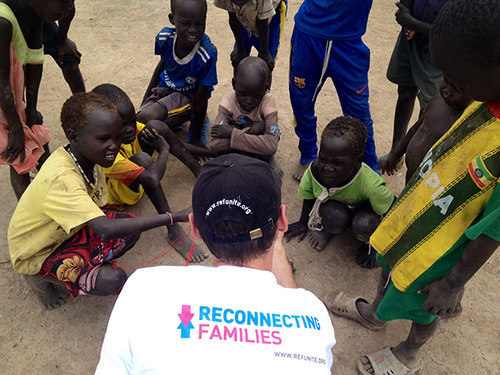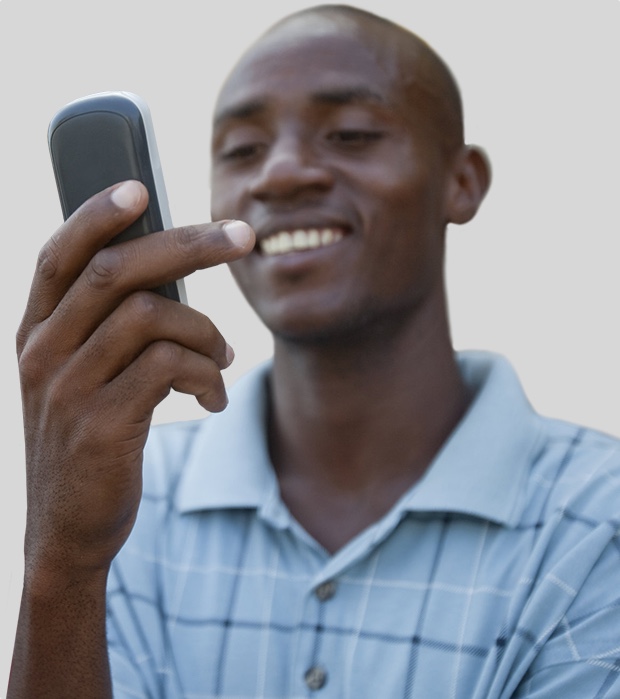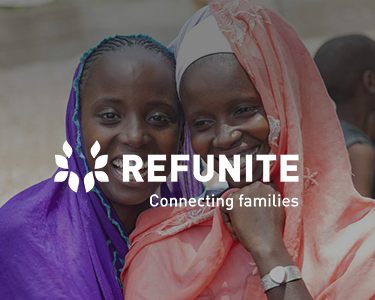
Zac Halbert is working as a Product Lead for a tech organization in San Francisco. He is also the American winner of the Global Hack for Good organized by Ericsson and REFUNITE. In this blog-post, he shares his experience creating a prototype for a ‘Messaging Wizard’ in Kakuma Refugee Camp
I recently returned from an excursion to Kakuma refugee camp in northern Kenya. Kakuma is home to about 125,000 refugees from all over Sub-Saharan Africa.

The goal of the trip was to build on the winning idea that was developed during the Hack for Good. During the hackathon, I created a mockup for a ‘Messaging Wizard’ together with my team in San Francisco.
The REFUNITE platform makes use of the USSD protocol, a system that most phones in Africa can access. It is used for mobile banking and is prevalent even when phones are not internet- or SMS-enabled. For now, it is the best technological option for use within a refugee camp.

One current challenge with REFUNITE’s USSD is that there is a 3 minute session timeout, making it difficult for some users to type a message to friends or relatives before getting kicked out of the system. The ‘Messaging Wizard’ only requires users to select from up to 4 options, or type single words. The bulk of the message is templated, allowing for greater message fidelity without running into the session timeout issue.
In Kakuma, my goal was to prototype the ‘Messaging Wizard’ to help families, who have been torn apart by war and famine, communicate with each other more effectively.
The challenge
REFUNITE is a technology-based nonprofit organization trying to tackle the challenge of reconnecting over 50 million forcibly displaced people.
To put it lightly, the challenges that the REFUNITE team face are complex. While it may seem that we were just a small part of the bigger picture, my team and I decided to tackle the problem of communication between refugees.
More than 360,000 people have signed up on the REFUNITE platform (www.refunite.org), making it the biggest platform for separated refugees and internally displaced people globally.

Now for the ‘Messaging Wizard’!
Once a person finds a potential loved one, they need to make sure the person is who they say they are. Many refugees have endured atrocities at the hands of authority figures and other adversaries.
As a result, they have deep-running fears and suspicions. They are reluctant to share personal information on the internet, lest they face a similar or even worse experience. Gun shy doesn’t even begin to describe it.
Currently, with the platform, a potential “match” has the option of writing a message to someone they think could be a family member. However, there are constraints that make this more challenging than it might initially seem.
Imagine the following context:
You are a refugee using the platform, either on your own or with the assistance of one of REFUNITE’s outreach volunteers. You see the name of a cousin that you lost contact with 10 years ago — someone you are not even sure is still alive.
You are in the middle of a camp, living in horrendous conditions with spotty network connectivity. This might be the first time you have used any kind of technology and you are only partially literate.
On top of that, you have two minutes or less to write a message before the USSD protocol times out, and you have to write a message on a very basic phone that has a 10-key input. (For example: typing the word “hello” requires typing 4,4,3,3,5,5,5,5,5,5,6,6,6) What would you say in this situation?
The solution
With these constraints in mind, we attempted to craft a ‘Messaging Wizard’ that would allow someone to write a short but elaborate message; detailed enough to help the recipient trust the sender’s portrayed identity.
The ‘Messaging Wizard’ also needed to address the technical constraints of the USSD platform, and ultimately reconnect more families quicker. During the initial hackathon, we created a prototype to effectively communicate our idea. (Click here to view the github repo)
In Kakuma, we decided to go as low-fi as possible and simulate USSD with paper prototyping (which is a fancy word for drawing stuff on paper).

We interviewed refugees who had successfully reconnected with lost family members to learn the following:
1. How they talk to a potential match,
2. What their concerns and expectations were before and after using the platform, and
3. To learn what else we had not thought about.
What I learned
The first thing I learned was that I had no inkling as to how complex the design needed to be. Here are the sample user stories that I wrote before going into the field:
- As a user who needs to write a message to a potential match, I need to easily perform some action every 2 minutes to keep the USSD connection alive so that I can communicate with the recipient.
- As a recipient of a message on the REFUNITE platform, I need to have enough information to be sure that I can trust the person writing me.
- As a user of the REFUNITE platform, I need to send enough information to a recipient so that they’ll know who I am, but not so much that I compromise security or safety.
After going into the field, I had to add more user stories that are certainly the strangest, most heart-breaking user stories I have ever written:
- As a mother, who was told that her child died 20 years ago when the war broke out, I want to know that this person writing me claiming to be my child is in fact related to me, so that we can be reunited.
- As an orphan responsible for the safety of my younger siblings, I need concrete information to confirm that the person contacting me is actually a relative wanting to help. I really want to improve quality of life, reunite with relatives, and avoid further hardships at the hands of those who would potentially exploit us.

After crying a little bit on the inside, I went to work, with guidance from REFUNITE’s tech team in Nairobi, attempting to address these challenges.
Modifying the solution
Based on what I learned, I modified the solution to simplify initial contact between two refugees. The use cases were so complex that attempting to structure all communication between parties was a fool’s mission.
I tried to make initial contact easier, but at the same time let both parties choose how they communicate once their identities are confirmed and trust is established.
With a progressive Q&A messaging system, we are able to maintain the USSD connection, require minimal reading or writing skills, and still end up with an elaborate and detailed message that a person can send to a potential match.
Questions such as:
“What is your father’s name?”
“What year were you born?”
“Where are you from?”
…were able to be answered with short words and phrases.
This kept the connection alive, and allowed technology to fill in the blanks. This series of short answers might result in a message such as this:
“Hello, my name is Mohammed Sayid, and my father is Maror. I’m originally from South Sudan, and I’m looking for my brother Hadi. I was born in 1976, and was separated from Hadi in 1991. I’m in Kenya now — do you have any information on the whereabouts of Hadi? Thank you.”
Conclusion
The word “solution” may perhaps be too strong a word, but this modification of the platform could help people communicate with each other more effectively than the current free–form messaging system.
While technology can’t solve everything, it can still simplify processes that organizations like REFUNITE need to alleviate the suffering witnessed in refugee camps like Kakuma.
Ultimately, I feel honored to have been part of a project with such noble goals. For people who have lost everything, helping them find the most important thing in the world – family – is an immensely rewarding and worthwhile experience.
The global Hack for Good was powered by Ericsson and REFUNITE.
MEDIA CONTACT
Ida Jeng, Director of Global Communications for REFUNITE (ij@refunite.org)


